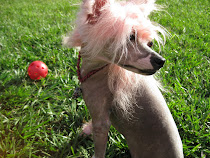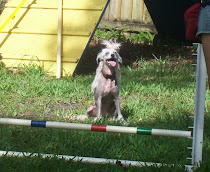Tuesday, March 17, 2009
First let me state that I am not a canine nutritional expert or a veterinarian. My way of feeding my dogs is just that--my way. There are many other diets out there and many opinions on this subject. I am simply offering what I have learned over the course of many years of preparing my dogs' meals.
While the prospect of making your own dog food and being responsible for your dog's nutritional needs rather than blindly relying on what's inside a bag or can may sound daunting, it is something that--once you do it a few times--will help you to gain confidence and feel much better about taking that big step.
First decide whether you will be feeding a raw, modified raw or a cooked diet. There are many resources for each on the internet. There are many pros and cons for each method and everyone has their own opinions and ideas on what they feel comfortable doing. I myself feed a modified raw diet. My dogs get raw meaty bones, raw fruits and veggies, semi-cooked meats and cooked pastas. They also get cottage cheese, yogurt, eggs, ground eggshells and oatmeal. I also supplement with an organic kibble (both for crunch and so that they are used to eating it when we travel or have a dogsitter come in) as well as use a multivitamin supplement. More about all that later. ;-)
First we'll start with your dog's activity level and age, to determine who needs what. If you have young, active working dogs who are expending a lot of energy, their needs are going to be different than say an older, more sedentary pet dog. Puppies need more protein than older dogs. I generally like a 70/30 mix. 70 percent protein, 30 percent everything else. Take a look at the ingredient lists of several different bags and cans of premium commercial dog food. While many of the feeding suggestions should definately be taken as a guide and not gospel, look at the differences between Puppy, Adult and Senior diets. This will help you as you formulate the appropriate protein ratio for your dog's diet. If you have multiple dogs of different ages/dietary requirements, this can get a little trickier. No worries, though. You can do it! ;-)
As we know, dogs are carnivores. While it is possible to feed a dog a vegetarian diet with substituted proteins, we will not be addressing that here. Here we will be addressing the average household dog and how we can feed them a well-balanced homemade diet that's not only good for them, but palatable as well. So on to the first ingredient--meat!

Organic vs non-organic. I am a believer in organics. I feed my family organically and this includes the pets whenever possible. Getting your hands on organic meats can be difficult, however. While organic meats are more expensive than conventional meats, they are free of growth hormones, pesticide and antibiotic residues and other chemicals that I would rather not put into my body or my dog's. Sometimes, however, organic or natural meats are not easily accessible and we must settle for what we can get at the local store. I generally prepare my dog food for the week, so I shop for meats for the dogs while I do my regular grocery shopping. I have been very pleased to find that some of the larger chain superstores now carry a pretty good selection of organic and natural meats, and the prices are getting better. There are those times, though, when I can't find what I need in the organic or natural section and occasionally have to settle for non-organic.
Single vs multiple proteins. A single-protein diet is, in my opinion, not the best way to go. I prefer to rotate proteins. Beef one or two days, turkey the next, fish (wild-caught not farm-raised) the next, etc. I have found that by introducing a young pup to as many different protein sources as possible helps to minimize sensitivities to any one particular protein. Chicken, for example, tends to be a protein that many dogs have problems tolerating. I fed chicken until a few years ago, when tainted chicken began entering the food supply and became big news. I'd not had a problem before and all of a sudden the dogs started exhibiting strange symptoms. I eliminated the chicken and everything went back to normal. I have tried some organic chicken since but they just don't seem to tolerate it as well so I just don't use it. There are many dogs, however, that do just fine with it. You will learn what your dog tolerates well and what he/she does not.
Certain breeds may be sensitive to certain proteins as well. Chinese Cresteds are said to be prone to lamb sensitivity, so I avoid using lamb in my Crested kids' diets. My non-Cresteds do well on it. Do a little research to see if your breed has any specific dietary allergens.
Beef is a staple around here. There are many parts of the cow that are useful in canine diets, such as tripe (stomach), intestines, heart, tongue, cheekmeat and liver. Go sparingly with liver, however, as it can cause loose stools if you feed too much. I generally save liver for making dog training treats. It is something that they only get while training, and they love it, hence it remains a special once-in-a-while treat.
Fish is also a favorite protein, as it is packed with omega-3 fatty acids. All those fish oils make for a fabulously shiny coat. Ever see the containers of fish oil for sale in pet stores? It's a fabulous supplement. I have long used fish and fish oils for beautiful coats. It never disappoints. ;-) While fresh, wild-caught fish is the best, in a pinch you can use canned. I generally use salmon, but catfish, tuna, mackerel, cod and many others are good to use as well. After choosing a particular protein, I pair it with rice or some variety of pasta. Rice is my first choice, but the dogs love various pastas and tolerate them well so I do rotate different types of pastas. These days you can get organic rice and pasta quite reasonably at most grocery stores. I have a huge pot (my dog food pot as it has come to be known) and I will start the meat in some water first. As the meat is nearly done, I will add the rice or pasta. You can either slice the meat raw or slice it afterward. I generally take the time to slice it up raw, so that when I am preparing individual meals, I just scoop out what I need, without having to slice it up as I am making each bowl. Impatient dogs will generally drive me crazy if I do that. ;-)Stay tuned for the next installment!






































